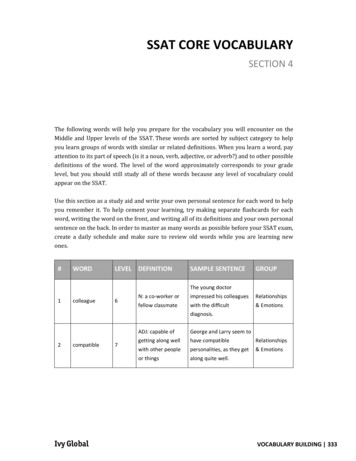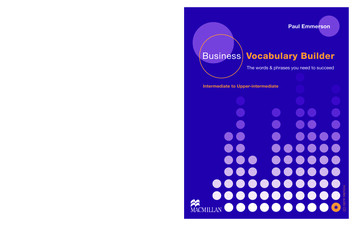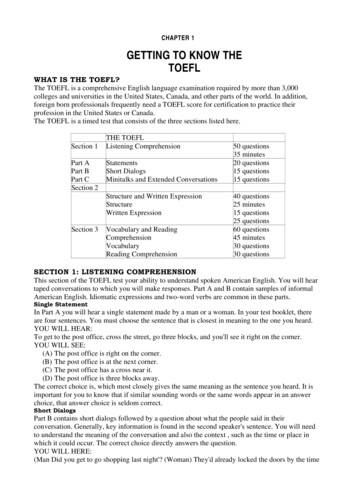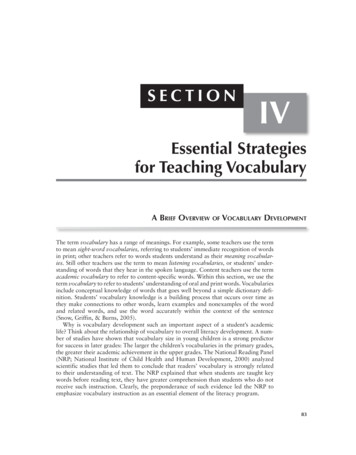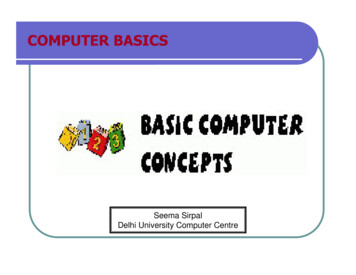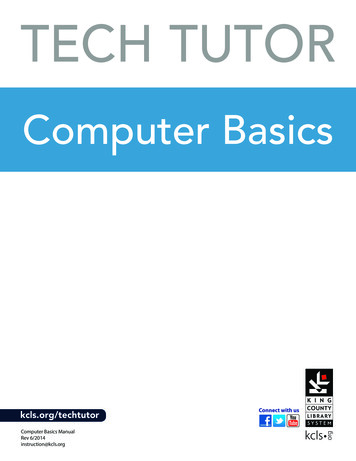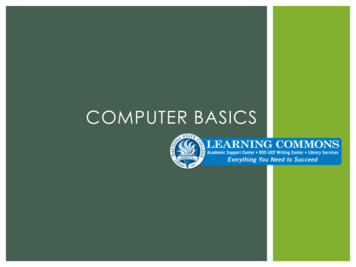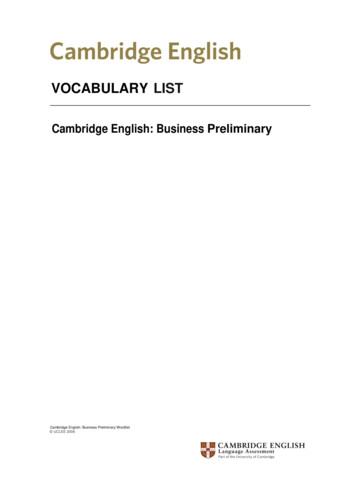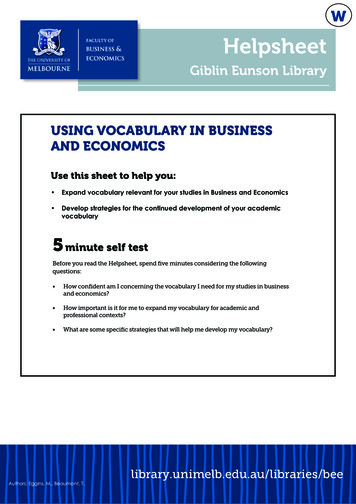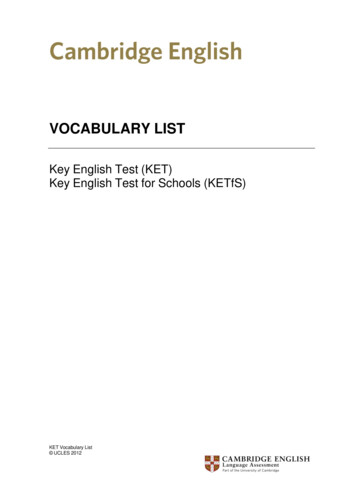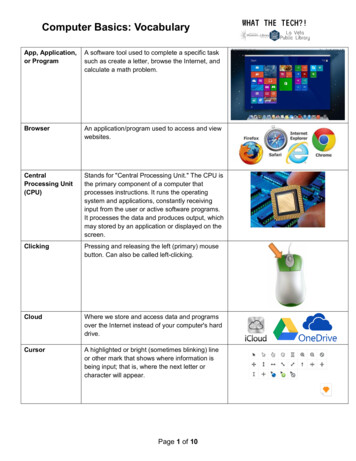
Transcription
Computer Basics: VocabularyApp, Application,or ProgramA software tool used to complete a specific tasksuch as create a letter, browse the Internet, andcalculate a math problem.BrowserAn application/program used to access and viewwebsites.CentralProcessing Unit(CPU)Stands for "Central Processing Unit." The CPU isthe primary component of a computer thatprocesses instructions. It runs the operatingsystem and applications, constantly receivinginput from the user or active software programs.It processes the data and produces output, whichmay stored by an application or displayed on thescreen.ClickingPressing and releasing the left (primary) mousebutton. Can also be called left-clicking.CloudWhere we store and access data and programsover the Internet instead of your computer's harddrive.CursorA highlighted or bright (sometimes blinking) lineor other mark that shows where information isbeing input; that is, where the next letter orcharacter will appear.Page 1 of 10
Computer Basics: VocabularyDefault"Factory setting" for any given option in asoftware program or operating system.DefragmentationDefragmentation is the process of consolidatingfragmented files on the user's hard drive. Theprocess of defragmentation moves the datablocks on the hard drive around to bring all theparts of a file together.DesktopThe "home screen" on your computer--what yousee when you first log on.Double-clickQuickly press and release the primary (left)mouse button twice.DownloadingTo download data or software means to transferit to your computer or phone from another deviceor from the internet.Drag and DropPoints the mouse at an icon or folder, pressesthe button and without releasing the button,moves the icon or folder to another place on thecomputer where the button is released.Page 2 of 10
Computer Basics: VocabularyEmailPrivate messages, called electronic mail, that aresent and received over a computer network.Email AddressYour “digital address” or where people can sendyou mail on the internet.External HarddriveAn external hard drive is a storage device locatedoutside of a computer that is connected througha USB cable or wireless connection. An externalhard drive is usually used to store media that auser needs to be portable, for backups, andwhen the internal drive of the computer is alreadyat its full memory capacity. These devices have ahigh storage capacity compared to flash drivesand are mostly used for backing up numerouscomputer files or serving as a network drive tostore shared content.File ExplorerDirectory that includes all Files and FoldersFileA piece of computer information-document,spreadsheet, music, video, etc.FolderJust like a file folder in a filing cabinet, a file iswhere documents (letters, spreadsheets, etc.)are kept.FontThe size and style of letters.sample font, SAMPLE FONT,sample font,FormattingChanging the way that text, graphics, tables andother elements looks on the page.Page 3 of 10fontSample Font, sample
Computer Basics: VocabularyHard driveLocated inside your computer; location whereyou store data including the operating system.HardwareThe physical equipment of the computer systemthat you can see and touch.HighlightClick and drag across a word or sentence tohighlight it. When it is highlighted you can makechanges to it.Hover (MousePosition the mouse pointer over top of an iconwithout clicking the icon.Over)IconA small picture used to represent a file orprogram.Input and InputDevicesWhenever you enter data into your computer, it isreferred to as input. This can be text typed in aword processing document, keywords entered ina search engine's search box, or data enteredinto a spreadsheet. Input can be something assimple as moving the mouse or clicking themouse button or it can be as complex asscanning a document or downloading photosfrom a digital camera. Input devices performthese tasks, sending information and instructionsto the computer.Page 4 of 10
Computer Basics: VocabularyInternetA network of computer networks.LinkShort for “hyperlink”--object or string of text thatallows you to "jump" to a new location.Usually blue.MaximizeWhen you maximize a window on your computerscreen, it becomes larger. In Windows,maximizing a window makes it take up the entirescreen. In Mac OS X, a maximized windowtypically only takes up as much space as itneeds.MenuA list of operations available to the user of aprogram. Menus can be accessed a variety ofways, including both left and right click.MinimizeWhen you minimize a window, you hide it fromview. This is commonly done to unclutter thedisplay or to view other open windows withoutclosing the current window. In Windows,minimizing a window will create a button for it inthe taskbar. In Mac OS X, an icon for theminimized window is added to the right size ofthe dock.ModemThe hardware that allows computer to connect tothe internet.MotherboardThe motherboard is a computer’s centralcommunications backbone connectivity point,through which all components and externalperipherals connect.Page 5 of 10
Computer Basics: VocabularyNetworkA collection of computers that are connected.OperatingsystemMost important software on the computer;controls the hardware and makes it possible torun other types of software.Output andOutput DevicesData generated by a computer is referred to asoutput. This includes data produced at a softwarelevel, such as the result of a calculation, or at aphysical level, such as a printed document.Output devices perform these tasks by sendinginformation or instructions to a user or device.PasswordA secret word or phrase used to accessinformation stored on a computer or computernetwork.Pointersthe symbols that appear on the computer screenthat indicate your movement of the mouse.Power Button(on/off)Activates or Deactivates a particular device.Page 6 of 10
Computer Basics: VocabularyRAMRandom access memory (RAM) is a type of datastorage used in computers that is generallylocated on the motherboard. This type of memoryis volatile and all information that was stored inRAM is lost when the computer is turned off.Volatile memory is temporary memory.Right-clickTo press and release the right button on themouse. Usually pulls up shortcut menu optionsfor the program upon which you've clicked.RouterA device that plugs into a cable or phone line andbroadcasts the digital signal wirelessly. Thisdevice is what make WiFi possible.ScrollControl which portion of the document is visiblein the window; available either horizontally orvertically or both. There are multiple ways (alldepending on your device) to perform thisfunction.Scroll BarA vertical bar on the right side of a window or ahorizontal bar at the bottom of a window that isused to move the window contents up and downor left and right.Scroll WheelThe center wheel/button on a mouse thatperforms a range of special page movementfunctions.Page 7 of 10
Computer Basics: VocabularySearch engineand PrivateSearch EngineA tool for finding information on theInternet. Examples are Google and Yahoo. Aprivate search engine is a search engine thatdoesn’t track its users, and delivers searchresults with added layers of protection.SelectTo point to an object and then press and releasethe primary (left) mouse button. There aremultiple ways (all depending on your device) toperform this function.SoftwareThe instructions that tell the computer what to do;the programs of the computer system.TabsIn a program, such as an Internet browser, a tabis one of several small, labeled, clickable, areasat the top of a window. Tabs allow you to switchbetween separate documents or web pages. Canbe used within programs or browsers.Taskbar (Dock on The taskbar is an element of an operating systemMac)located at the bottom of the screen in windows(called a Dock in Mac). It allows you to locateand launch programs through Start and the Startmenu, or view any program that is currentlyopen.UploadingTo transfer (data or programs) from a peripheralcomputer or device to a central computer orwebsite.USBUniversal serial bus, a standardized technologyfor attaching peripheral devices to a computer.Page 8 of 10
Computer Basics: VocabularyWebpageA document that lives on the World-Wide Web.WebsiteA location connected to the Internet thatmaintains one or more pages on the World WideWeb.Wi-FiTechnology that allows computers and otherdevices to communicate over a wireless signal.WindowA “box” that appears on top of the desktop. It isthe portal or way in which you interact with anapp.Page 9 of m
Computer Basics: VocabularyPage 10 of 10
Computer Basics: Vocabulary Page 7 of 10 RAM Random access memory (RAM) is a type of data storage used in computers that is generally located on the motherboard. This type of memory is volatile and all information that was stored in RAM
